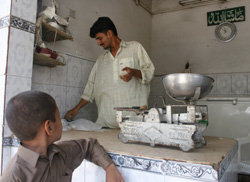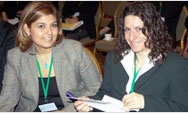You are here » Home » Telling Our Story
Case Study
Strengthening small-loan firms and expanding small businesses
Small Loans Plug the ‘Missing Middle’

| |
Photo: USAID/Kaukab Jhumra Smith
|
|
Zahid Husain, right, serves a customer at his brother Shahid’s milk shop in Hijrat Colony, Karachi.
“A higher loan cap gives us the flexibility to finance those clients who are prospering and growing,”said Asif Siddiqi, managing director of a USAID-funded small-loan firm serving Karachi, Lahore, and Peshawar.
|
Challenge
Small businesses in Pakistan find it hard, even impossible, to get a loan. Most banks provide loans above 500,000 rupees ($8,300), while small-loan institutions usually give loans under 30,000 rupees ($500). In between lies the “missing middle,” a need for small loans to help small businesses grow their assets and income until they can become clients of large banks. This need was left unfulfilled because the financial sector questioned its long-term viability. “We kept facing one problem, and that was accessing long-term funds in the local markets,” said Asif Siddiqi, managing director of Network Leasing Corporation, a small-loan institution that serves low-income urban areas. “Banks were not sure if this was a sustainable operation.”
Initiative
To strengthen small-loan firms, also known as microfinance institutions, and facilitate larger loans to small businesses, USAID funded a three-year, $6.3 million program with the government-sponsored Pakistan Poverty Alleviation Fund. Select small-loan institutions in low-income areas received funding to offer loans of 30,000 to 100,000 rupees. Siddiqi embraced the initiative. “The funding from USAID has helped us continue our operations,” Siddiqi said. In two years, his staff has grown 25 percent to 103 employees and his clients have doubled to 8,000.
Results
“The majority of our clients are doing better as time goes by,” said Siddiqi. One client, Shahid Husain, runs a milk shop in Karachi’s Hijrat Colony, where few residents own refrigerators. With a 75,000 rupee loan, he bought a chilling machine to store raw milk longer. His daily sales jumped from four drums of milk to nine. Aleemuddin Khokhar, who makes metal parts for local factories, invested several loans into machinery and grew his monthly orders to 1.7 million rupees. He has applied for a 1 million rupee loan from a large bank. With this smart investment, USAID is helping local institutions fill in the “missing middle” and groom their clients for bigger banks and higher profits.
Print-friendly version of this page (533kb - PDF)
Click here for high-res photo
Back to Top ^ | 

